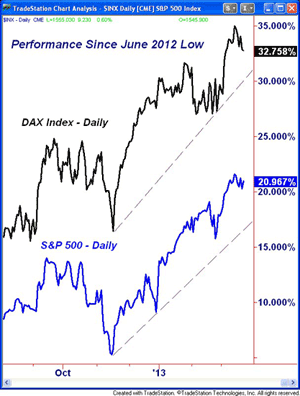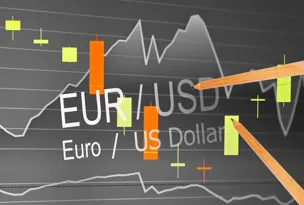Increasingly daring market forecasts should unpleasantly remind savvy investors of the exuberance of Y2K, and the truth is that the market is very difficult right now. In his weekly review, MoneyShow's Tom Aspray suggests that there will be more lucrative battles to fight later this year.
Last week's action in the stock market shows perfectly what I meant a few weeks ago by a Veg-O-Matic market.
The S&P 500 closed lower Monday, Tuesday, and Thursday and up Wednesday and Friday. The end result was a slightly lower weekly close...and we may see similar action this week.
From a sentiment standpoint, I did not like the fact that Morgan Stanley's Adam Parker turned bullish for the first time since 2010, having raised his 2013 S&P forecast from 1,434 (last November) to 1,600. Also joining the bulls was Meredith Whitney, who is well remembered for her headline-grabbing warning about the municipal bond market.
It was also not encouraging that two other institutional strategists raised their targets for the S&P 500 to 1,625, from 1,575 and 1,600 respectively. And to make matters worse, on Friday morning an analyst predicted that the Dow would reach 25,000 by 2017. I need to upgrade my crystal ball.
But all of this does not mean that the market has completed a top, as the intermediate-term technical outlook is still positive. However, it may entice more into the market at the wrong time, which could lead to a deeper correction later in the year.
Global markets were spooked by the EU plan to tax bank deposits in Cyprus in exchange for the much-needed bailout. This was subsequently rejected by the Cypriot lawmakers...but they don't have much time for an alternate plan. Last week, I expected the Euro crisis to eventually spook the markets, but I didn't expect it so soon.
The prospect of similar action against Italy, Spain, or Greece is the contagion that worries the markets. A late headline from the Financial Times on Friday suggested the same confiscation could happen in the UK. New talks got underway Friday, which once again helped to support the markets, but the crisis will continue to be in the headlines this week.
The impact on the German Dax was minimal; it still shows a clear uptrend. and is up almost 33% since the June 2012 lows. This is about 12% better than the S&P 500 over the same period. Both show solid uptrends, and it would take a convincing break below the February lows to weaken their outlook.
So far in 2013, the only place to be has been the stock market. The 2013 Performance charts shows that the Spyder Trust (SPY) is up just under 9%, while crude oil is about flat. The SPDR Gold Trust (GLD) was down over 3% so far this year, as was the iShares Barclays 20+ Year Treasury ETF (TLT).
NEXT: What to Watch
|pagebreak|There was more positive data on the housing sector last week, even though the NAHB Housing Index dropped from 47 to 44. Housing starts improved a bit, and the chart looks quite strong.
Housing starts broke through resistance (line a) in late 2011. They are continuing to make higher highs above support (line b). Existing home sales were also strong last Thursday, as they jumped 0.8%.
The Leading Indicators were also higher last Thursday as eight out of ten components showed monthly gains. The coincident indicators also improved suggesting that economic growth is continuing with no recessions on the horizon.
In this holiday-shortened week, there is a full slate of economic data. We begin on Monday with the Dallas Fed Manufacturing Survey, followed on Tuesday by durable goods, the S&P Case-Shiller Housing Price Index, and consumer confidence.
Pending home sales are out on Wednesday, and then GDP and jobless claims on Thursday. On Friday, even though the stock market is closed, we get the final reading for March on consumer sentiment from the University of Michigan.
What to Watch
The major market averages closed the week lower despite Friday's nice rebound. There's still no new all-time high in the S&P 500, which I do not yet see as a problem, although the financial media will probably starting picking up on it in the coming weeks.
A couple of weeks of choppy trading or a deeper correction would not only help to increase the bearish sentiment, but might take some of the strong stocks I like back to support. This would provide much more attractive entry levels and stop placements.
Definitely, it is a time to be very selective, and I will look to be lock in some profits on existing positions next week.
Last week, there was another shift in individual investor sentiment, as the bullish percentage dropped from 45.4% back to 38.9%. Most of this change reflected movement into the neutral camp.
The financial newsletter writers also became less bullish, declining slightly from 50% to 47.4%. However. the bearish percentage also declined a bit more, to 18.6%. Over the next few weeks, it would be nice to get this number get back to at least 25%.
Last week, the NYSE Composite dropped below the prior week's low, but closed at the upper end of the week's range. The week's low at 8,968 corresponded nicely to the February high of 9,004, which is the first good support.
There is more important support at 8,700, which was the late February low, and the rising 20-week EMA is close by at 8,721. The weekly Starc- band is now at 8,655.
The weekly NYSE Advance/Decline line made another new high last week, which is bullish for the intermediate term. A year ago, the A/D line formed a trading range and then a divergence (yellow circle), which warned of the three-month correction that ended at the June lows.
NEXT: Stocks and Tom's Outlook
|pagebreak|S&P 500
The Spyder Trust (SPY) dropped to a low of $153.59 last Tuesday (line 1), and then closed the week well above the lows. The daily Starc- band is now at $152.72, with the February correction low at $148.74.
The daily on-balance volume (OBV) did confirm the price highs on March 14, and also made a new high. It is slightly below its WMA, but well above support (line b). The weekly OBV (not shown) is still acting very strong, so both time frames are still pointing higher.
The S&P 500 A/D line also made a new high with prices, and is now testing its WMA. It is still above both short-term (dashed line) and longer-term support (line c).
The first weekly support is at $151.50, which was the recent low, and then $148.73. The rising 20-day EMA is at $148.33.
Dow Industrials
The SPDR Diamond Trust (DIA) held up well last week, and is still trading near its new all-time high at $145.35. It closed pretty much unchanged for the week, and the recent range on the daily chart (see circle) could just be a short-term continuation pattern or a pause before further new highs.
The rising 20-day EMA is now at $143.06 and has not been tested all month. There is further support at $141.37 and then $140.58.
The daily Dow Industrials A/D line is acting positive, having held above its WMA, and has stayed in a tight range. There is long-term support at line b.
Nasdaq-100
The PowerShares QQQ Trust (QQQ) again tested its uptrend that goes back to last year's late lows (line b), then closed the week back above its 20-day EMA. There is first good support now at $67.63 (line 4), followed by the $66 area.
The Nasdaq-100 A/D line was stronger on the previous rally, and is also looking a bit more positive. A daily close above $69.02 may be enough to signal a stronger rally back to the next resistance at $69.76.
It will take a stronger rally to turn the other technical studies on QQQ positive.
Russell 2000
The iShares Russell 2000 Index (IWM), like the Dow Industrials, held up well last week, closing with a slight loss for the week.
The trading over the past seven days looks like just a pause in the uptrend. The hourly chart of IWM (see insert) shows a flag formation, which is a typical continuation pattern.
The OBV and Russell 2000 A/D line both made new highs with prices in the middle of the month, and the daily OBV has now dropped slightly below its WMA. The A/D line is also testing its WMA, with further support at line f.
There is minor support now at $93.06 and the 20-day EMA, and then $92.68, which was the February high.
NEXT: Sector Focus, Commodities, and Tom's Outlook
|pagebreak|Sector Focus
The iShares Dow Jones Transportation (IYT) closed over 1% lower last week, and a further correction may give us an opportunity in the trucking stocks. Trucking is currently the weakest of the five industry groups that make up the Transports.
There are no signs of a top yet for IYT. First good support sits between $107 and $108.76.
In last week's article The Best Bull Market Sectors, I took a technical look at the four best-performing sectors since the March 2009 low, and how they have done so far in 2013.
This chart shows the other four major sectors that have underperformed the Spyder Trust (SPY) since the 2009 low.
The most surprising for most will be Select Sector SPDR Health Care (XLV), which is up just over 85%. It has held up quite well during the market corrections, and broke through 12-year resistance last year.
Health care is still one of my favorite sectors to watch. I focused on biotechnology, which is one of its industry groups, in last Friday's column.
Meanwhile, Select Sector SPDR Materials (XLB), Select Sector SPDR Energy (XLE), and Select Sector SPDR Consumer Staples (XLP) have lagged the SPY by 10% to 15% since 2009.
Of these, the only real star performer last week was the Select Sector SPDR Consumer Staples (XLP), which was up 2%. Most of the other sectors were down, led again by the Select Sector SPDR Materials (XLB), down 2%, and the Select Sector SPDR Financials (XLF).
Crude Oil
The May crude oil contract was about as choppy as the stock market last week. Prices rose on Monday, Wednesday, and Friday and were lower Tuesday and Thursday. The price of crude oil closed down just slightly for the week.
The technical pattern suggests a bottom was made early in the month. Crude does have a seasonal tendency to bottom in February and then rise through the early summer. The OBV is acting stronger than prices, and a strong close above the $98.50 level would break trend line resistance (line a).
Precious Metals
The outlook for the Spyder Gold Trust (GLD) has improved. The weekly OBV is now testing its WMA. Still, I would look for confirmation before venturing back on the long side, as prices are often choppy during the spring.
The Week Ahead
I continue to advise that only selective buying should be done. This is a much more difficult market than it was earlier in the year.
Also, if you have a nice 15% or 20% profit in any of your stocks, consider selling part of it and raising some cash. There will be a better buying opportunity in the coming months.
I can't reinforce enough that you should have a plan and stops in place so you won't have to make a tough decision if the Dow opens down a couple of hundred points. Look for an update for the Charts in Play Portfolio early in the week.
- Don't forget to read Tom's latest Trading Lesson, The Most Powerful Pivot Level










































